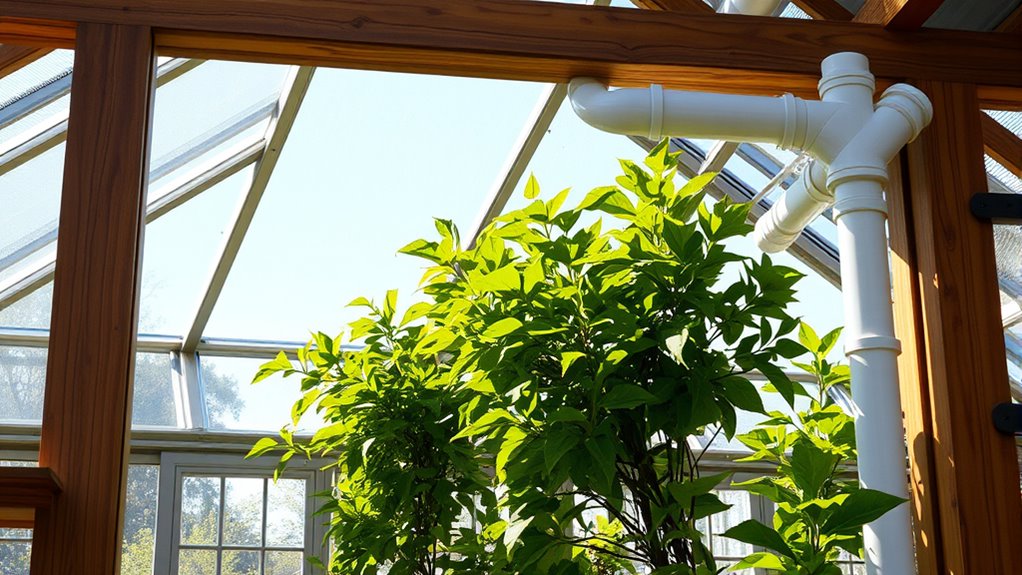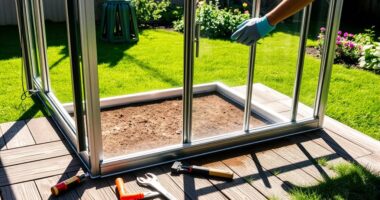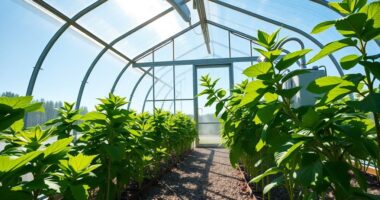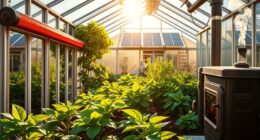When choosing a greenhouse frame, you’ve got three main options: wood, metal, and PVC. Wood offers natural insulation and aesthetic charm but needs regular maintenance. Metal frames are durable and low-maintenance, though they can be pricier and less visually appealing. PVC is affordable and lightweight, ideal for temporary setups, but it may not hold up in harsh conditions. Each material has its own pros and cons, so let’s explore what suits your needs best.
Key Takeaways
- Wood frames provide natural insulation and aesthetic appeal but require regular maintenance and are heavier, necessitating a strong foundation.
- Metal frames, particularly aluminum, offer durability, low maintenance, and structural integrity but can be more expensive and may overheat in summer.
- PVC frames are lightweight and budget-friendly, ideal for temporary setups, but lack the durability of wood and metal options.
- Consider your budget, climate, and desired lifespan when choosing between wood, metal, and PVC for greenhouse frames.
- Design flexibility varies by material, with wood allowing for custom designs and metal and PVC offering simple, adaptable options.
Overview of Greenhouse Frame Materials
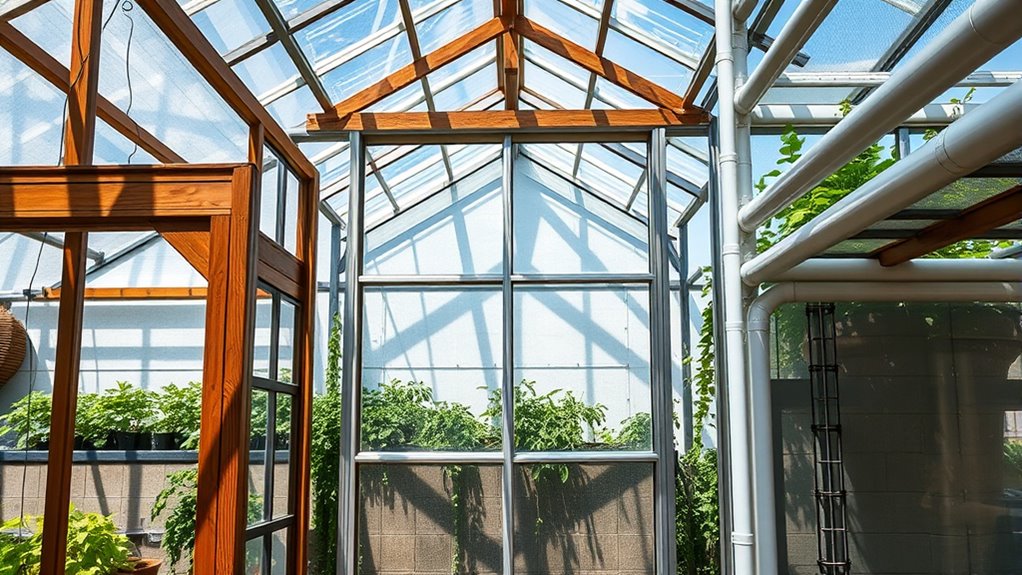
When choosing a greenhouse frame, you’ll find several material options that each offer unique advantages.
Wood, metal (like galvanized steel and aluminum), and PVC are popular choices. Metal frames are generally more durable than wood and PVC, making them a long-term investment.
Wood, metal, and PVC each have unique advantages, but metal frames stand out for their durability and long-term value.
PVC is often the most affordable and lightweight option, ideal for hobbyists or temporary structures. However, it lacks the durability of metal or wood.
If you prioritize low maintenance, metal frames, particularly aluminum, offer corrosion resistance and ease of assembly.
Consider your budget, climate, and how long you want your greenhouse to last when making your decision. Each material has its benefits, so weigh your options carefully to find what suits your needs best.
Advantages of Wood Frames
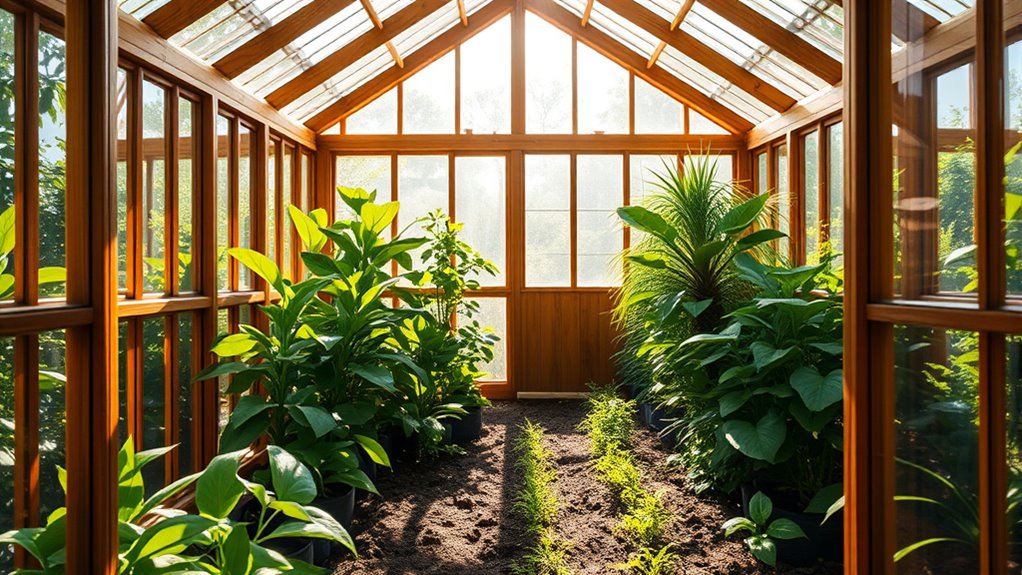
Wood frames offer a range of advantages that make them an appealing choice for greenhouse construction. Their natural insulation helps maintain stable temperatures, reducing energy costs by minimizing the need for heating or cooling. Raw foods can also benefit from the stable environment that wooden greenhouses provide, allowing for optimal growth conditions. Additionally, solar energy systems can be effectively utilized alongside wooden greenhouses to further enhance energy efficiency.
Furthermore, the use of wood can contribute to better indoor air quality, as wood has the ability to regulate humidity levels naturally. Additionally, wooden structures can incorporate sustainable building materials, further enhancing the ecological benefits of greenhouse construction. You’ll appreciate how wood regulates temperature fluctuations, creating an ideal environment for your plants.
Aesthetic-wise, wooden greenhouses exude a classic charm that blends seamlessly with nature, while also allowing for customization to match your garden’s style.
Practically, wood provides ample storage space and supports hanging plants, enhancing functionality.
Plus, as a renewable resource, wood contributes to ecological balance by storing carbon dioxide. Sustainable practices can further enhance the benefits of using wood, ensuring that its environmental impact remains positive.
With proper treatment, wood frames boast durability and longevity, ensuring your greenhouse stands strong for years to come.
Disadvantages of Wood Frames
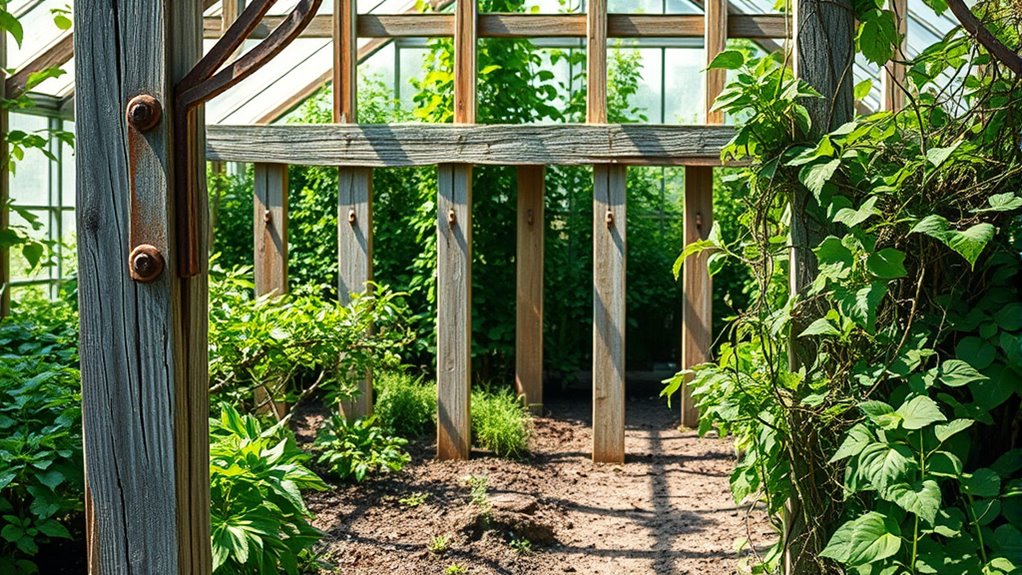
While wood frames have their charm, they come with several disadvantages that can impact your greenhouse experience.
First, wood requires regular maintenance to prevent rot and decay, which can be costly and time-consuming. You’ll need to apply preservatives and paint, often needing to temporarily remove plants.
Wood demands ongoing upkeep to avert rot and decay, often requiring costly preservatives and paint, along with the hassle of relocating plants.
Additionally, wood is susceptible to moisture issues, leading to warping and cracking, and it’s heavier, requiring a more substantial foundation. This material can also be more expensive upfront, especially if you choose high-quality types.
Constructing a wooden greenhouse is labor-intensive and may demand skills you don’t have.
Finally, wood frames don’t perform as well in extreme weather without proper care, potentially leading to further issues down the line.
Advantages of Metal Frames

If you’re considering a greenhouse frame, metal offers compelling advantages that can enhance your gardening experience.
Metal frames are incredibly durable, resisting harsh weather conditions like heavy winds, rain, and snow. They also fend off pests and rot, ensuring a longer lifespan than wood.
With excellent structural integrity, metal supports various roofing materials, while galvanized steel shines in cold climates.
Maintenance is a breeze—no repainting or treatment needed—saving you time and money.
Metal frames are cost-effective, easy to assemble, and customizable, fitting both small gardens and large commercial setups.
Plus, with energy-efficient designs that optimize growing conditions, metal frames provide a practical, sustainable choice for your greenhouse.
Disadvantages of Metal Frames

Despite the numerous benefits that metal frames offer, there are several disadvantages to consider before making your decision.
First, metal frames, especially aluminum, can be more expensive than alternatives like PVC, increasing your overall greenhouse costs.
Aesthetically, metal may not rival the appeal of wood, and finding the right size or shape can be a challenge, limiting your customization options.
Additionally, metal’s thermal conductivity can cause overheating in summer and difficulty maintaining warmth in winter, potentially stressing your plants.
Condensation issues may arise, promoting algae growth and requiring regular cleaning.
Lastly, while generally durable, metal frames can rust and necessitate proper anchoring and maintenance to ensure structural integrity, especially in harsh weather conditions.
Advantages of PVC Frames
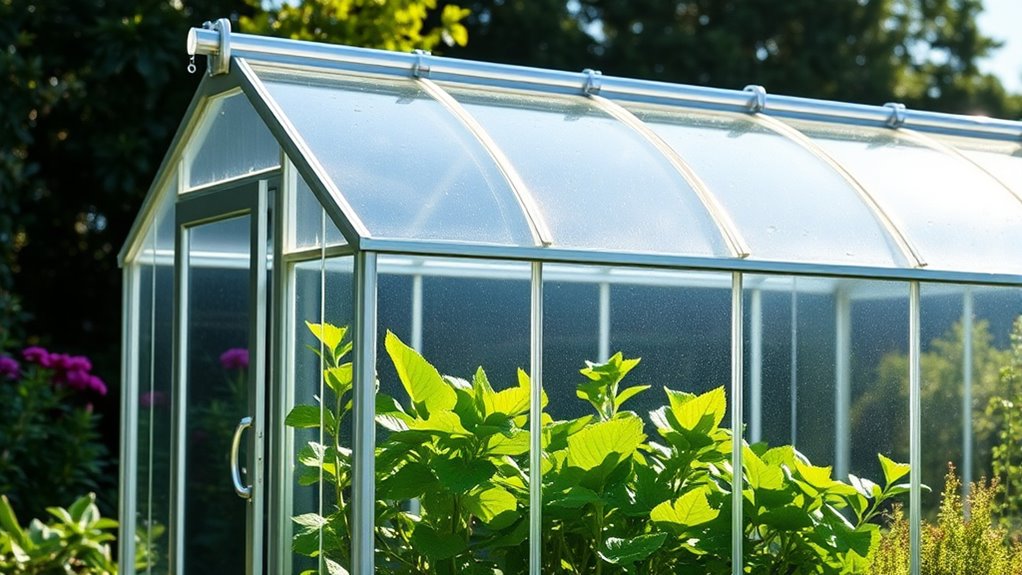
When it comes to greenhouse frame materials, PVC frames stand out for their affordability and ease of use.
They’re the least expensive option, allowing you to build a greenhouse for a few hundred dollars. If you’re a DIY enthusiast, you’ll appreciate that PVC is easy to assemble and requires minimal tools, making it perfect for your projects.
Plus, with accessible plans available online, you can get started right away. PVC frames are lightweight, portable, and can withstand adverse weather conditions without rotting or rusting.
With easy online plans, PVC frames are lightweight, portable, and built to withstand the elements.
They efficiently retain temperatures, ensuring healthy seedling growth. Overall, PVC frames provide a budget-friendly and practical solution for your greenhouse needs, making them an attractive choice for gardeners of all levels. Additionally, they offer extended gardening season benefits, allowing you to grow a wider variety of plants year-round.
Disadvantages of PVC Frames
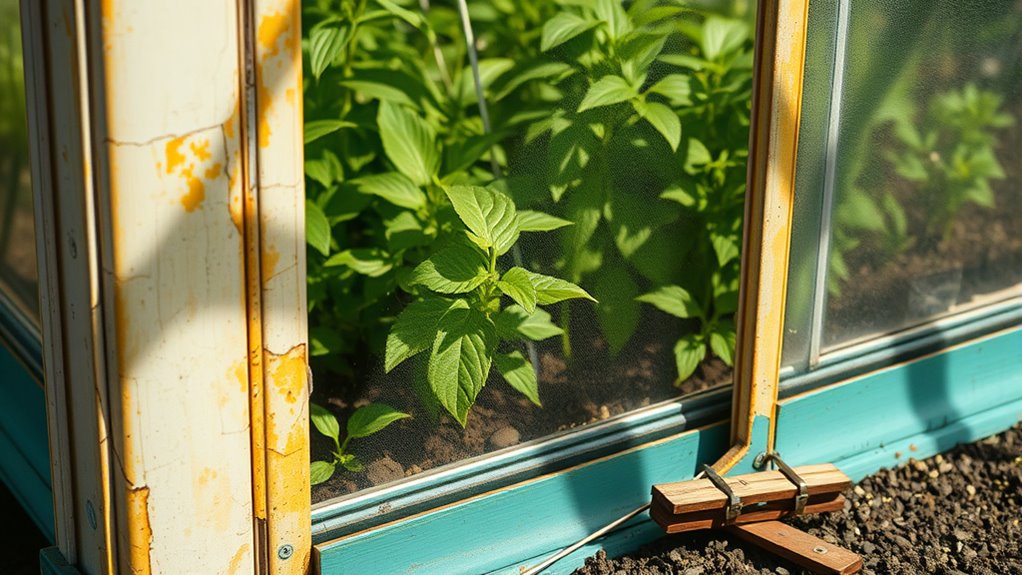
While PVC frames offer many benefits, they also come with significant drawbacks that can impact your greenhouse experience. One major concern is UV degradation; over time, exposure to sunlight can weaken the material.
Additionally, PVC frames struggle against extreme weather conditions like strong winds and heavy snow, risking structural failure. In colder climates, PVC can become brittle, compromising stability.
Although they last 20 to 30 years, they may not withstand harsh environments without extra support, like steel reinforcements.
Lastly, installation might seem straightforward, but you’ll likely need additional structures to ensure long-term durability, and regular maintenance is essential to keep them effective.
These factors can make PVC frames less appealing for your greenhouse needs.
Comparing Aesthetic Appeal
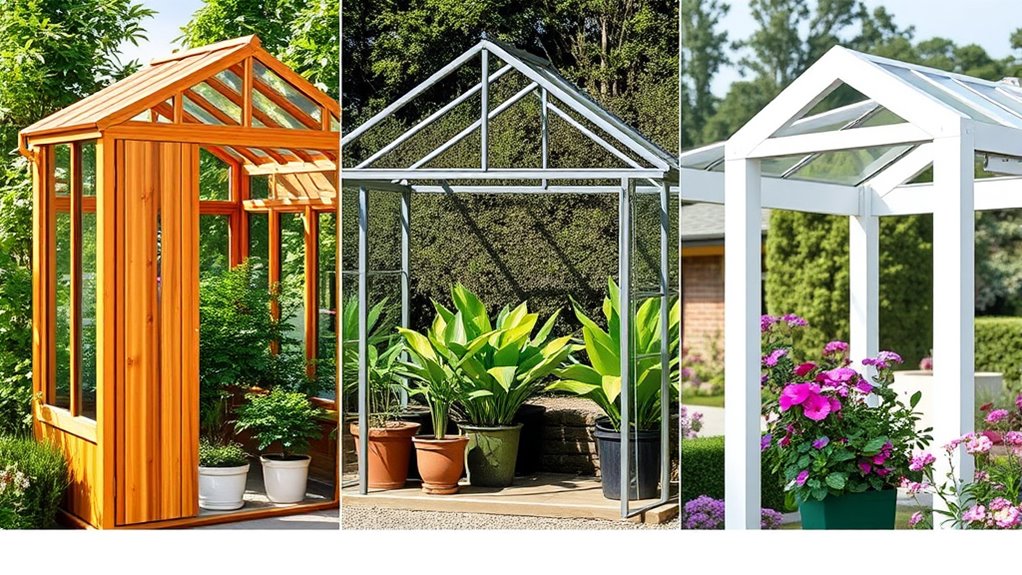
As you consider the aesthetic appeal of greenhouse frames, it’s essential to recognize how different materials can shape your overall gardening experience.
Wood frames provide a natural look that blends seamlessly with your garden, offering customization and a classic charm.
In contrast, metal frames, especially aluminum, deliver a sleek, modern appearance with clean lines and a sense of durability.
PVC frames offer simplicity, with a lightweight and unobtrusive design that can be easily customized in various colors.
While wood and metal can make a stronger visual statement, PVC’s clean appearance keeps the focus on your plants.
Ultimately, your choice will reflect your style, whether you prefer the warmth of wood, the modernity of metal, or the simplicity of PVC.
Choosing the Right Frame for Your Greenhouse
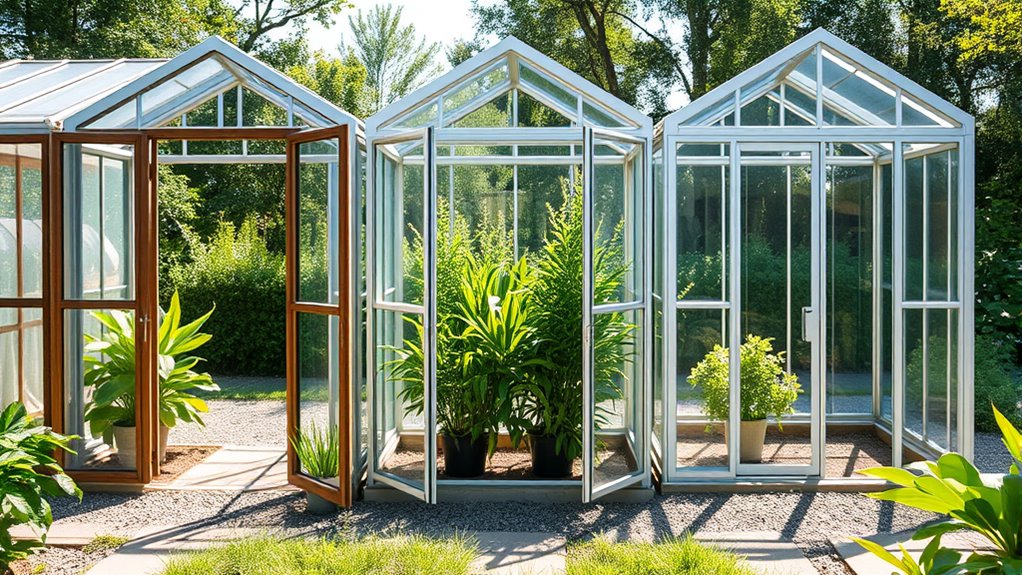
Choosing the right frame for your greenhouse is crucial to ensuring that it meets both your aesthetic and functional needs.
Consider your budget first; wooden frames are affordable but heavy, while PVC offers the lowest cost for small setups.
For durability, aluminum frames resist corrosion and need minimal upkeep, whereas galvanized steel provides unmatched strength, ideal for harsh climates.
If you seek versatility, wooden frames allow custom designs, and composite materials blend strength with low maintenance.
Think about where you live—aluminum works well in coastal areas, whereas galvanized steel excels in cold climates.
Ultimately, weigh your priorities: cost, durability, and design flexibility to select the best frame for your greenhouse project.
Frequently Asked Questions
How Do I Properly Maintain a Wooden Greenhouse Frame?
To properly maintain a wooden greenhouse frame, you should regularly clean it with warm soapy water and check for any signs of rot or damage.
Conduct semi-annual inspections, removing any rotted wood and using filler to repair areas.
Reapply protective coatings annually to keep the wood shielded from the elements.
Don’t forget to check for loose parts and ensure everything’s secure, especially before winter and after the growing season.
Can I Combine Different Materials for My Greenhouse Frame?
“Don’t put all your eggs in one basket.” Yes, you can combine different materials for your greenhouse frame!
Mixing materials can boost durability and enhance aesthetics, allowing you to tailor your structure to your needs.
Just keep in mind potential compatibility issues and maintenance complexities.
By carefully choosing materials, you can create a strong, visually appealing greenhouse that stands up to environmental challenges.
What Is the Average Lifespan of Each Frame Material?
The average lifespan of greenhouse frame materials varies significantly.
Wood frames typically last about 10 to 15 years, but require maintenance to prevent decay.
Metal frames, like aluminum, can endure for 50 years or more, while galvanized steel generally lasts 20 to 30 years, offering durability and strength.
PVC isn’t usually used for structural frames, so its lifespan isn’t applicable in that context.
Choosing wisely can save you time and money in the long run.
How Do Local Climate Conditions Affect Frame Material Choice?
Local climate conditions significantly impact your choice of frame material.
If you live in humid areas, you’ll want to avoid wood due to rot. For coastal climates, aluminum’s corrosion resistance is crucial. In regions with heavy snowfall, opt for sturdy materials like metal or composite.
High UV exposure can make PVC brittle, so consider insulation needs too.
Ultimately, understanding your climate helps you select the most durable and effective frame for your greenhouse.
Are There Eco-Friendly Options for Greenhouse Frame Materials?
Did you know that using reclaimed wood can reduce the demand for new lumber by up to 60%?
When considering eco-friendly options for your greenhouse frame, you’ve got choices like sustainably harvested wood, lightweight aluminum, or even recycled PVC.
Each option minimizes environmental impact while providing durability.
Bamboo frameworks and composite materials also offer sustainable alternatives.
Conclusion
As you stand at the crossroads of your greenhouse journey, remember that the frame you choose shapes not just your plants, but your entire gardening experience. Whether you envision a rustic wooden haven, a sleek metallic fortress, or a whimsical PVC retreat, each material tells a story. Consider your needs and aesthetics, and let your greenhouse bloom into a sanctuary that reflects your passion, much like a painter choosing the perfect canvas for their masterpiece.
